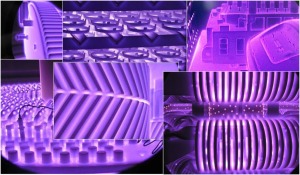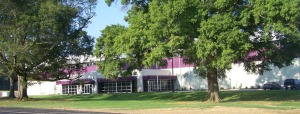Category Archives: Ion Nitriding
When and Why Ion Nitriding/Nitrocarburizing Makes Good Sense
When and Why Ion Nitriding/Nitrocarburizing Makes Good Sense
Advanced Heat Treat staff Dr. Edward Roliński and Gary Sharp authored this article from Industrial Heating magazine, August 11, 2005:
Ion, or plasma, nitriding has been studied and used industrially for more than 40 years [1-8], but the technology has not been used to its full potential. Ion nitriding/nitrocarburizing is a low temperature (800-1100˚F, or 430-595˚C) process, which results in little or no distortion of the treated parts even if significant residual compressive stress is induced to the surface layer of the treated products. The ion nitriding process also has been referred to by other surface treating characteristics including plasma, vacuum, diffusion, low nitriding potential, passive surfaces activating, easy-to-control structure and pollution-free processes. These process characteristics with the exception of the low nitriding potential concept are discussed in the literature.”
Click here to read the entire article:
http://www.industrialheating.com/Articles/Feature_Article/f022e50797cb7010VgnVCM100000f932a8c0
Learn more about the authors here www.ahtweb.com
Nitriding and Nitrocarburizing
Nitriding/Nitrocarburizing Types:
- Ion Nitriding (Plasma Nitriding / Nitrocarburizing)
- Gas Nitriding (Gaseous Nitrocarburizing)
- Salt-Bath Nitriding (Liquid)
Photo of Ion Nitriding:
Case Depth Terms
When applying a heat treatment, such as ion nitriding, to a part, it is important to know the following case depth terms:
Effective Case Depth (ECD):
The distance from the surface of a hardened case where a specified level of hardness is maintained (typically 50 HRC eqv.).
Total Case Depth (TCD):
The distance from the surface of a hardened case to a point where differences in physical properties of the case and core are no longer distinguished (visual or hardness method).
For example:
 For more information, visit www.ahtweb.com.
For more information, visit www.ahtweb.com.
Honda To Expand Production Of Light Trucks, Engines At Alabama Plant
Honda To Expand Production Of Light Trucks, Engines At Alabama Plant.
Bloomberg News (11/15, Ohnsman) reports, “Honda Motor Co., Japan’s third- largest automaker, will spend $84 million and hire 100 more workers to expand production of light trucks and engines at its assembly plant in Alabama.” In a statement, Honda said that “the investment will boost annual capacity for the Lincoln, Alabama, plant to 340,000 vehicles and engines by 2013 from 300,000 now.” Bloomberg News notes, “Asian automakers including Honda are expanding output capacity in North America as US sales recover from a recession in 2008 and 2009. Demand for new cars and trucks grew 10 percent this year through October, and most companies and analysts are forecasting total sales of 12.5 million to 13 million vehicles in 2011.”
The AP (11/15) reports, “The $1.5 billion plant began production with the Odyssey minivan. The plant employs about 4,000 people and is the sole North American producer of the Odyssey, the Pilot SUV and the Ridgeline pickup.”
The Birmingham Business Journal (11/15, Poe, Subscription Publication) reports, “The latest investment, which brings Honda’s total investment this year up to $275 million and 140 jobs, is tied to the addition of the Acura MDX luxury SUV to the plant’s production lineup, the company said.”
On its website, WLTZ-TV Columbus, GA (11/15) notes, “In 2013, the Lincoln plant will start making the luxury Acura MDX sport utility vehicle.”
Also covering the story are the Anniston Star (11/15, McCreless), WVTM-TV Birmingham, AL (11/15, Jackson) and other media sources.
Read the article here: http://www.businessweek.com/news/2011-11-16/honda-expanding-alabama-plant-to-lift-light-truck-engine-output.html
Did you know Advanced Heat Treat Corp. has a location in Alabama?
The Cullman Facility is located at: 1545 County Rd. 222 Cullman, AL 35057 and specializes in heat treat services such as: Ion Nitriding, Ferritic Carburizing, Stress Relieve, Oxidation Treatment, Duplex Hardening, Assembly, Cleaning Applications, Metallurgical Services & Consultation, Tempering/Drawing, Polishing, and Failure Analysis.
Ion Nitriding Frequently Asked Questions
Will my part have any growth and/or shrinkage from UltraGlow® Ion Nitriding?
Generally, your parts will have minor growth depending on the process that you are requesting. The growth will be dependent on the amount of compound zone (white layer) that is required/achieved during processing. The standard rule of thumb is ~70% of the CZ Layer thickness.
How does AHT know that my parts met the right hardness and case depth specified?
When processing your parts, an AHT sample of similar material and/or customer supplied sample will be processed with the parts. After processing, a full metallurgical evaluation will be performed in order to document the results achieved.
What will happen to parts that I have repair welded?
The weld repair should nitride dependent on the material. If you have made weld repairs, it is imperative that you provide the welding material to AHT prior to processing as it may respond different to nitriding than the base material(s).
I have heard of UltraGlow® Ion Nitriding but do not know exactly what it is?
The process is conducted in a vacuum chamber back-filled to a very low pressure with a mixture of nitrogen and other gases. A high voltage electrical charge forms plasma from the gas mixture. Nitrogen ions then accelerate through the plasma and impinge on the workpiece. The ion-bombardment process heats the workpiece, cleans its surface, and results in absorption of active nitrogen into the surface of the material producing a “hardened case”.
How long does UltraGlow® Ion (Pulse Plasma) Nitriding take?
Due to the various materials and/or requirements the UltraGlow® Ion (Pulse Plasma) Nitriding process can take anywhere from a few hours up to a few days.
What do I need to do to my parts after UltraGlow® Ion Nitriding?
UltraGlow® Ion (Pulse Plasma) Nitriding is generally performed on “finished” machined parts. After processing, a light polishing of the part(s), if required, will bring your part back to the required surface finish with no affect to the nitrides.
What information do you need before you can quote/process my parts?
At a minimum, we need the following information:
• Material/Steel number
• Type of heat treat requested
• Surface hardness
• Case depth
You may also include the following additional information:
• Core hardness
• Selective location for heat treat
• Any previous heat treat/thermal processing on parts
When is carbonitriding better than carburizing?
Carbonitriding (CN) is a very effective case hardening process, and it can be used on a variety of low carbon steels. CN is well suited for sheet steel and 10xx, 11xx, and 12xx series steels. The addition of nitrogen to the case hardening process allows the case hardened layer to react and form a harder case than would typically be provided with carburizing alone. The CN is also a lower temperature process, which can contribute to lower distortion.


